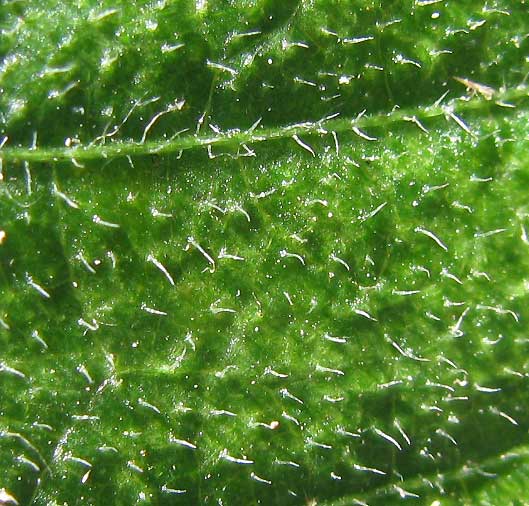Excerpts from Jim Conrad's
Naturalist Newsletter
from the January 31, 2010 Newsletter issued from Hacienda Chichen Resort beside Chichén Itzá Ruins, central Yucatán, MÉXICO; limestone bedrock, elevation ~39m (~128ft), ~N20.676°, ~W88.569°
WILD PETUNIA #3 & ITS CYSTOLITHS
In the November 15th Newsletter I introduced a "Mexican Wild Petunia" growing from sidewalk cracks before my bungalow here, which still can be seen at http://www.backyardnature.net/yucatan/ruellia.htm.
There I told of the pleasure I get from comparing species belonging to the same genus. In that instance I compared the sidewalk plant, Ruellia nudiflora, with another wild petunia, Ruellia caroliniensis, I'd met not long before in Mississippi, still profiled at http://www.backyardnature.net/n/h/ruellia.htm.
Nowadays one of the most eye-catching wildflowers blooming along trails in the woods here is yet another wild petunia -- RUELLIA INUNDATA. You can see it below:

If you savor "variations on a theme," which is what comparing species within a genus is all about, you might enjoy going from one link to another, seeing all the differences, yet also noting the basic structural sameness among them. For example, the flowers among the three species all have violet-to-blue colors, all have funnel-shaped corolla tubes with five rounded lobes that flare outwardly, all are slightly bisymmetrical instead of radially symmetrical, and all have two anthers barely peeping from the corolla tube (with two more anthers unseen inside).
Among the differences are that our Ruellia inundata is much larger (up to five feet here) and has a semi-woody, or "suffrutescent," base, but has smaller flowers than the others.
Another big difference is in the leaves. Not only are the leaves of Ruellia inundata much hairier than the other two species, but also its leaves' surfaces are "bumpier." A closer look at this bumpiness is shown below:

Ruellia inundata's leaves are bumpy because they are packed with "cystoliths." You can think of a cystolith as like a tiny, sandgrain-like gristle suspended within leaf tissue -- like the softish grit in old-time varieties of pear. More technically, a cystolith is an inorganic concretion, usually of calcium carbonate (limestone), formed in a cellulose matrix in special cells. They're restricted to a few plant families, such as Ruellia's Acanthus Family, the Acanthaceae. In that family, some genera produce them and some don't. The presence or absence of cystoliths can be important to note when identifying plants. The other two Ruellias mentioned above also have them, but they're not as pronounced as in Ruellia inundata.
I've always assumed that cystoliths were supposed to make it harder for herbivores such as caterpillars to eat the leaves. I ate a Ruellia inundata leaf, however, and couldn't detect any grittiness at all.
Ruellia inundata occurs from Mexico deep into South America.